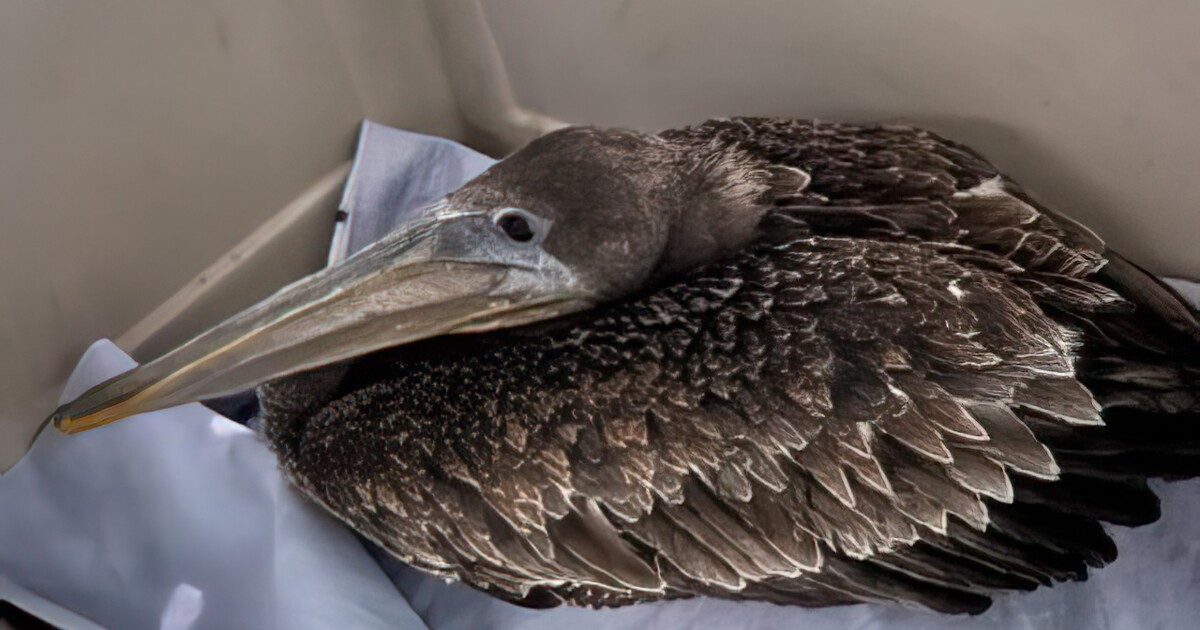Have something to say? Lookout welcomes letters to the editor, within our policies, from readers. Guidelines here.
The injured pelican sat immobile on a piece of pipe at the Santa Cruz Harbor, near Seabright State Beach.
Its foot was bloody and it was tethered to rocks 20 feet away by a long piece of fishing line. Miraculously, it had managed to swim to the rampart pipe and had stationed itself there, staring out at the water.
Maria Viveros, a Native Animal Rescue (NAR) volunteer, had noticed the pelican and called me via the NAR hotline to see if there was anything we could do. I immediately contacted our rescuer, Connie Maschan, to get eyes on it, then Greg Cotten, who hopped into his dinghy right away and went over to Seabright.
Native Animal Rescue volunteer Greg Cotten was able to corral this pelican entangled in fishing line.
(Via Connie Maschan)
I have worked for Native Animal Rescue for seven years, first as a volunteer and now as wildlife supervisor. When I first signed on with the organization as a volunteer, it was during the spring baby season, and it was mainly to help with the feeding of the baby songbirds, which I was proficient at since acquiring a wildlife degree in college some 20 years ago.
Most wildlife rehabilitation facilities cater to one type of animal, birds or mammals, seabirds or carnivores, but I realized quickly that Native Animal Rescue catered to absolutely everything. Seabirds, songbirds, raptors, all mammals (excepting mountain lions), even our beloved dusky-footed woodrat, are welcome here.
Unfortunately, stories like this poor pelican’s happen regularly.
From 2016 to 2021, we rescued around 1,500 animals a year. In the past two years, those numbers have doubled to about 3,000 a year.
Native Animal Rescue has been around 44 years, and most of the animals come because of human conflict or contact. That could be a car strike, a fishing entanglement or a cat-caught songbird. Often, wild creatures — raccoons, rabbits, skunks, pelicans — have ingested or become entangled in plastic.
Too many situations that could be avoided.
A container full of fishing hooks and line Native Animal Rescue has pulled out so far in 2023.
(Via Connie Maschan)
That’s why NAR, a community based nonprofit, is open every single day of the year. Wildlife doesn’t take holidays, so neither do we. We rescue, rehabilitate and release back to the wild the injured, orphaned or entangled wildlife. We partner with International Bird Rescue to ensure the best veterinary care for our seabirds and the Exotic Pet Clinic of Santa Cruz for our other birds, mammals and reptiles.
We train rehabilitators and volunteers, who go out into the community to rescue the wildlife that cannot be brought to us, an invaluable service in a place like Santa Cruz, which is a city, but is still a very, very wild place.
We recently helped a gray fox who had a tight piece of plastic around her neck. A group of neighbors spotted and captured her. We removed the plastic, rehabilitated her for several weeks, then returned her to her home and to her mate. The entire neighborhood came out (and hid at a distance) to watch her bolt out of the kennel and head to her den and family.
Native Animal Rescue of Santa Cruz County recently rescued this pelican entangled in fishing line in the Santa Cruz Harbor.
(Via Connie Maschan)
Many times we receive dozens of calls a day about birds with fishing hooks in their mouths or bodies that people can’t capture or help. I’ve been on numerous daring rescues myself, particularly in those first few years, which I will always remember. Many times, pelicans would be hobbled on the beach in Davenport, and I would be overjoyed to help.
In the case of the Seabright pelican, Greg pulled his dinghy up slowly, netted the terrified bird and snipped the fishing line that attached her to the rocks. He then brought her to us, where we worked to remove two hooks and the line.
She weighed about 6.9 pounds and stayed with us for two days before being transported to International Bird Rescue. The hooks and line caused damage to her legs, but the prognosis is good, and we are all hopeful.
Without help, the pelican surely would have perished.
When I hear stories like this, I’m still as amazed as I was that first day I walked in here. Watching the animals, some in very bad shape upon arrival, thriving under this roof makes the work worthwhile.
Amy Red Feather is the wildlife supervisor at Native Animal Rescue of Santa Cruz County.
(Via Amy Red Feather)
We can’t keep all wildlife safe. But we can be careful. I understand, fishing lines can often be irretrievable. But, if you do lose a line, please make an effort to find it. And clean up your discarded line when possible. If you do happen to snag a seabird, please don’t tear the hook out, as this can cause irreparable harm. Call us. We will help.
Living in such a wild place, it is inevitable that most people will run into wildlife at some point. Knowing what to do when that happens can not only help our wildlife thrive, but can help prevent wildlife/human conflicts from becoming an issue.
If you see an injured creature, call us. We would be happy to come and help.
Amy Red Feather is the wildlife supervisor at Native Animal Rescue of Santa Cruz County. The NAR hotline is 831-462-0726.
